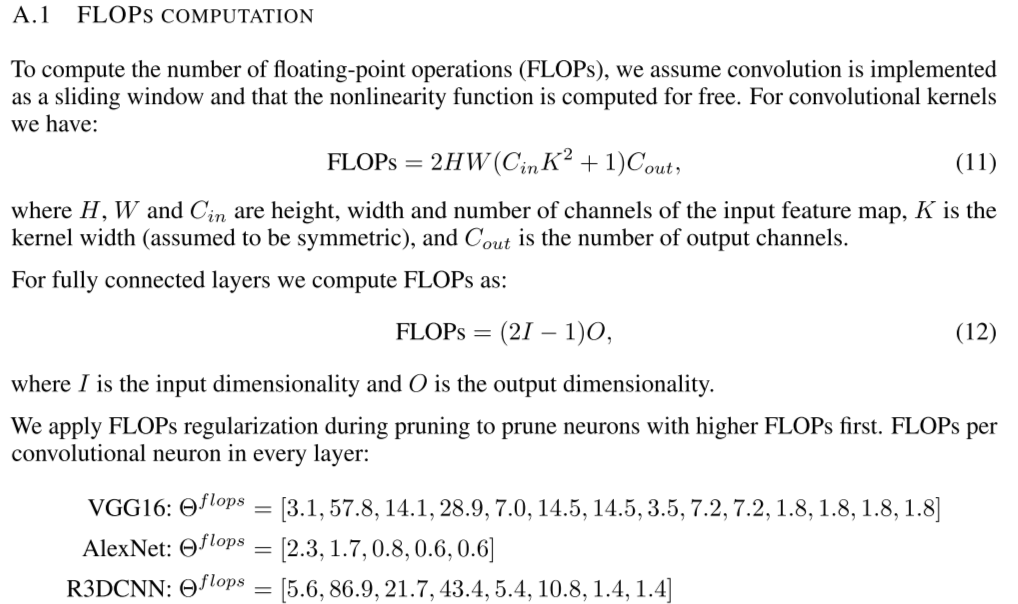- FLOPS: floating point operations per second,每秒浮点运算次数,计算速度,衡量硬件性能的指标 (大写S代表秒)
- FLOPs: floating point operations,浮点运算数,计算量,用来衡量算法/模型的复杂度。
- Params:没有固定的名称,大小写均可,表示模型的参数量,也是用来衡量算法/模型的复杂度。通常我们在论文中见到的是这样:#Params,那个井号是表示 number of 的意思,因此 #Params 的意思就是:参数的数量。
FLOPs与模型时间复杂度、GPU利用率有关,Params与模型空间复杂度、显存占用有关
MAC:Multiply Accumulate,乘加运算。乘积累加运算(英语:Multiply Accumulate, MAC)是在数字信号处理器或一些微处理器中的特殊运算。实现此运算操作的硬件电路单元,被称为“乘数累加器”。这种运算的操作,是将乘法的乘积结果和累加器的值相加,再存入累加器:
a←a+b×c
使用MAC可以将原本需要的两个指令操作减少到一个指令操作,从而提高运算效率。
FLOPs的计算
不考虑激活函数的计算量

卷积层

全连接层

Code
完整参数量统计
1
2
3
4
5
6
7
8
9
10
11
12
13
14
15
16
17
18
19
20
| import torch
from torchvision.models import resnet50
import numpy as np
Total_params = 0
Trainable_params = 0
NonTrainable_params = 0
model = resnet50()
for param in model.parameters():
mulValue = np.prod(param.size())
Total_params += mulValue
if param.requires_grad:
Trainable_params += mulValue
else:
NonTrainable_params += mulValue
print(f'Total params: {Total_params / 1e6}M')
print(f'Trainable params: {Trainable_params/ 1e6}M')
print(f'Non-trainable params: {NonTrainable_params/ 1e6}M')
|
1
2
3
4
5
| >>> output:
Total params: 25.557032M
Trainable params: 25.557032M
Non-trainable params: 0.0M
|
简单统计可训练参数量
1
2
3
4
5
6
| import torchvision.models as models
model = models.resnet50(pretrained=False)
Trainable_params = sum(p.numel() for p in model.parameters() if p.requires_grad)
print(f'Trainable params: {Trainable_params/ 1e6}M')
|
1
2
3
| >>> output:
Trainable params: 25.557032M
|
统计每一层
1
2
3
| model = vgg16()
for name, parameters in model.named_parameters():
print(name, ':', np.prod(parameters.size()))
|
1
2
3
4
5
6
7
8
| >>> output:
features.0.weight : 1728
features.0.bias : 64
features.2.weight : 36864
features.2.bias : 64
features.5.weight : 73728
...
|
使用thop库来获取模型的FLOPs(计算量)和Params(参数量)
1
2
3
4
5
6
7
8
9
10
| import torch
from thop import profile
from archs.ViT_model import get_vit, ViT_Aes
from torchvision.models import resnet50
model = resnet50()
input1 = torch.randn(4, 3, 224, 224)
flops, params = profile(model, inputs=(input1, ))
print('FLOPs = ' + str(flops/1000**3) + 'G')
print('Params = ' + str(params/1000**2) + 'M')
|
1
2
3
4
| >>> output:
FLOPs = 16.446058496G
Params = 25.557032M
|
Ref:
https://blog.csdn.net/weixin_44966641/article/details/120104600




